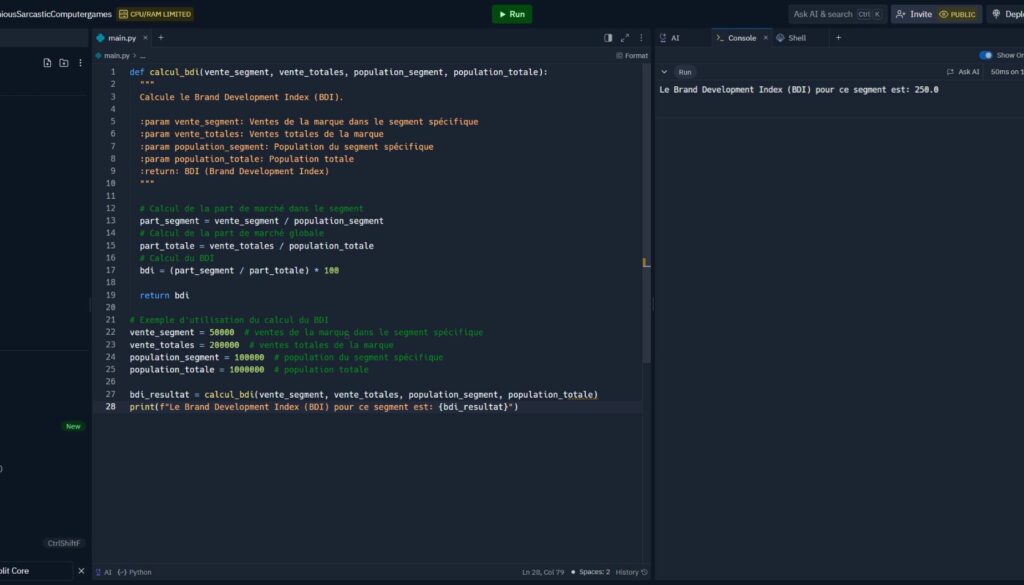The Brand Development Index (BDI) is an indicator that measures a brand’s relative performance in a particular market segment (e.g., geographic region, demographic group, or other segmentation criteria). It enables this performance to be compared with the brand’s overall performance in the market as a whole.
BDI objective
The purpose of BDI is to identify whether a brand performs better or worse in a specific segment compared to its overall performance. A BDI above 100 indicates that the brand is stronger in this segment compared to its average performance, while a BDI below 100 shows that it performs less well in this segment.
How is BDI calculated?
The formula for calculating BDI is as follows:
BDI = (Segment market share / Total market share) × 100
Where:
- Segment market share = (brand sales in segment) / (segment population)
- Total market share = (total brand sales) / (total population)
This means that we compare the brand’s market share in a specific segment with the overall market share to see if the brand is over- or under-performing in that segment.
Python example
def calcul_bdi(vente_segment, vente_totales, population_segment, population_totale):
"""
Calcule le Brand Development Index (BDI).
:param vente_segment: Ventes de la marque dans le segment spécifique
:param vente_totales: Ventes totales de la marque
:param population_segment: Population du segment spécifique
:param population_totale: Population totale
:return: BDI (Brand Development Index)
"""
# Calcul de la part de marché dans le segment
part_segment = vente_segment / population_segment
# Calcul de la part de marché globale
part_totale = vente_totales / population_totale
# Calcul du BDI
bdi = (part_segment / part_totale) * 100
return bdi
# Exemple d'utilisation du calcul du BDI
vente_segment = 50000 # ventes de la marque dans le segment spécifique
vente_totales = 200000 # ventes totales de la marque
population_segment = 100000 # population du segment spécifique
population_totale = 1000000 # population totale
bdi_resultat = calcul_bdi(vente_segment, vente_totales, population_segment, population_totale)
print(f"Le Brand Development Index (BDI) pour ce segment est: {bdi_resultat}")Code explanation
- Parameters:
vente_segmentrepresents brand sales in a specific segment (for example, a region or demographic group).vente_totalesrepresents the brand’s total sales in the market as a whole.population_segmentis the population of the segment in question.population_totaleis the total population of the entire market.
- Calculating market share in the segment: We first calculate the brand’s market share in the specific segment by dividing segment sales by segment population.
- Calculating overall market share: Next, we calculate the brand’s overall market share by dividing the brand’s total sales by the total population.
- Calculating BDI: Finally, BDI is obtained by dividing segment market share by total market share, then multiplying by 100 to obtain a percentage.
Interpretation of results
- If the BDI is above 100, this means that the brand is performing better in this segment than its average performance in the overall market.
- If the BDI is below 100, the brand is underperforming in this segment compared to its overall performance.
Example in figures
Suppose a brand achieves 50,000 sales in a segment with a population of 100,000. Over the whole market, this brand achieves 200,000 sales for a total population of 1,000,000. Applying the formula, we obtain a BDI of 250, showing that the brand performs particularly well in this segment.
Strategic implications
Marketing strategy
A high BDI may be an incentive to maintain or increase marketing investments in this region, while a low BDI may suggest developing specific advertising campaigns or promotions to boost sales.
Resource allocation
Companies can allocate more resources (advertising, distribution) in regions with high BDI, and explore the causes of poor performance in areas with low BDI.
Limits and considerations
Data quality
The BDI is based on accurate sales and population data. Errors in this data can distort the results.
Segmentation
BDI is often calculated for specific market segments (age, gender, income). Poor segmentation can lead to misinterpretation of the results.
Time horizon
BDI can vary over time according to changes in consumer behavior or market trends. It is therefore important to analyze it over relevant periods.
The CDI (Category Development Index)
Alongside the BDI, the CDI (Category Development Index) compares the performance of the entire product category in a given region. This helps to understand whether a brand is underperforming even in a growing category, or vice versa.
Conclusion
Summary of key points
BDI is a key indicator for assessing a brand’s performance in a specific region in relation to its total potential. It can be used to guide marketing strategies and resource allocation.
The importance of BDI in marketing decision-making
Using BDI, companies can better understand high-potential areas, adjust their efforts and optimize their development strategy to maximize success in different market regions.



